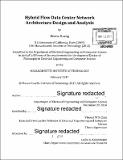Hybrid flow data center network architecture design and analysis
Author(s)
Huang, Henna Priscilla
DownloadFull printable version (13.49Mb)
Other Contributors
Massachusetts Institute of Technology. Department of Electrical Engineering and Computer Science.
Advisor
Vincent W.S. Chan.
Terms of use
Metadata
Show full item recordAbstract
In this thesis, we propose a hybrid flow network architecture for future data center. The hybrid flow architecture has its origins in the early 1990s with studies on all-optical networks and fiber-optical computer networks. Research in optical flow switching has spanned over two decades. Our contribution to the study of all-optical networks is on the performance of hybrid flow data center networks. We compare the delay performance of hybrid flow architectures and traditional packet switched networks in future data center. We present a simplified data center traffic model, where data center traffic is categorized into mice traffic and elephant flows. The electronic packet switched architecture allows for low overhead and complexity for small transactions. However, mice traffic suffers as the size, fraction, and arrival rates of elephant flows increase. In the hybrid flow architecture, elephant flows are transmitted on an all-optical flow-switched data plane, where wavelength channels are reserved for the duration of a flow. In addition, the hybrid flow architecture allows for the dynamic allocation of optical wavelengths. In electronic packet switched networks, wavelength assignments are static, where traditional networking protocols do not consider the optical domain in routing decisions. We show that the hybrid flow architecture allows for superior delay performance compared to the electronic packet switched architecture as data rates and data volume increase in future data center networks.
Description
Thesis: Ph. D., Massachusetts Institute of Technology, Department of Electrical Engineering and Computer Science, 2017. Cataloged from PDF version of thesis. Includes bibliographical references (pages 127-132).
Date issued
2017Department
Massachusetts Institute of Technology. Department of Electrical Engineering and Computer SciencePublisher
Massachusetts Institute of Technology
Keywords
Electrical Engineering and Computer Science.